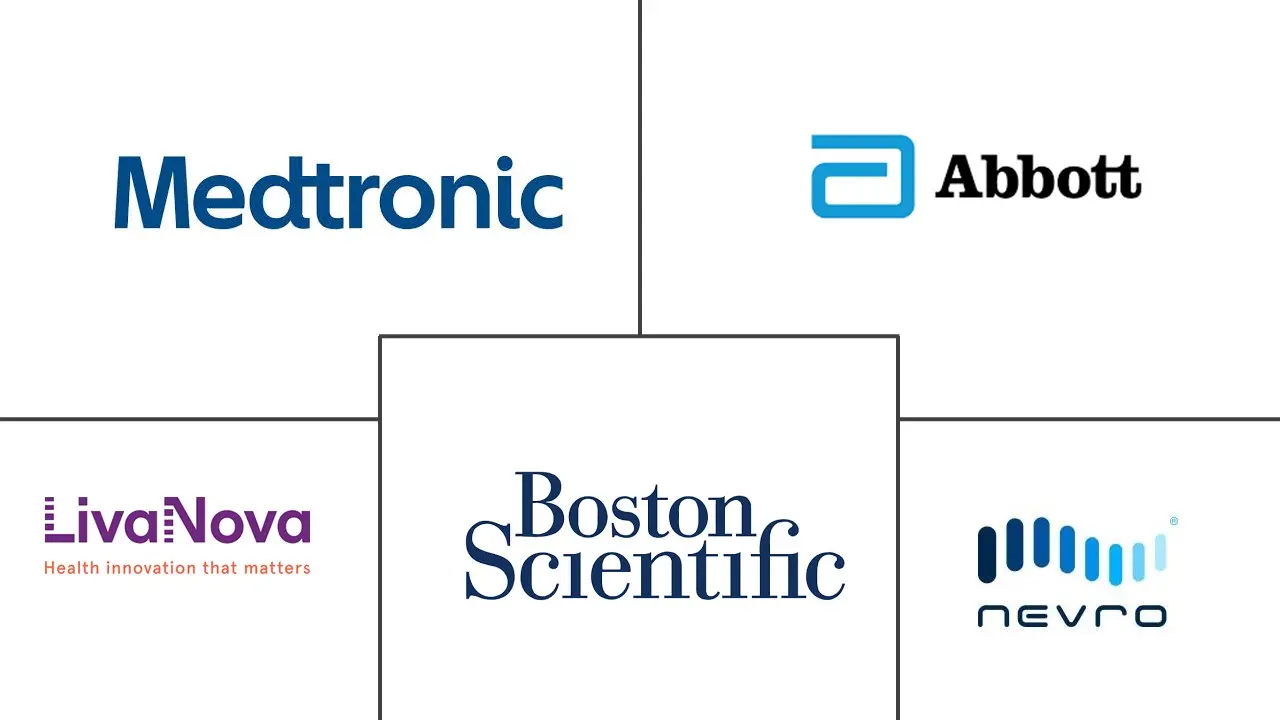Neuromodulation Market Size and Share
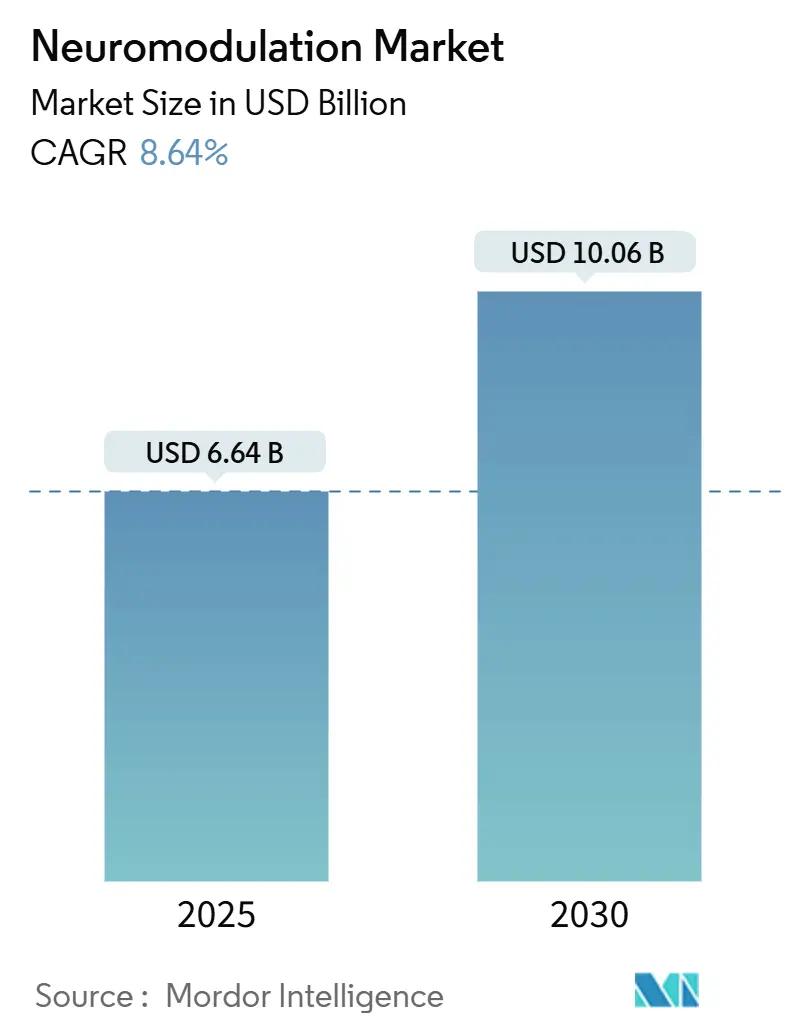
Neuromodulation Market Analysis by Mordor Intelligence
The neuromodulation market size is valued at USD 6.64 billion in 2025 and is projected to reach USD 10.06 billion by 2030, registering a steady 8.64% CAGR. Rising clinical adoption beyond chronic pain, the shift to rechargeable implantable pulse generators, and cloud-enabled data analytics are amplifying procedure volumes and accelerating vendor service revenues. Closed-loop spinal cord stimulators and deep-brain systems dominate because physicians can verify functional gains through real-time telemetry, reinforcing payer confidence. Regional expansion is equally pivotal: while North America still represents about 45% of global demand, Asia-Pacific centers are booking double-digit case growth, encouraged by universal insurance reforms and an ageing population demanding drug-free pain relief. Competitive moves now hinge on integrated hardware-software platforms; manufacturers that combine neuromodulation with remote programmers and analytics are shortening programming sessions for clinicians and expanding the neuromodulation market into outpatient pathways.
Key Report Takeaways
- By technology, internal systems led with a 70% neuromodulation market share in 2024; external systems are forecast to expand at a rate above the 10.1% industry CAGR through 2030.
- By application, pain management accounted for 45% share of the neuromodulation market size in 2024, while neurological disorders are advancing at a fastest growth rate of 11.4%.
- By end-user, hospitals and ambulatory surgical centers captured 60% of the neuromodulation market in 2024; other end-users are projected to post the fastest CAGR of 11.6% from 2025-2030.
- By geography, North America held 45% of revenue in 2024, whereas Asia-Pacific is projected to deliver a 9.9% CAGR to 2030, the highest among all regions.
Global Neuromodulation Market Trends and Insights
Drivers Impact Analysis
| Driver | (~) % Impact on CAGR Forecast | Geographic Relevance | Impact Timeline |
|---|---|---|---|
| Global rise in chronic neurological and pain disorders | +0.9% | Global | Long term (≥ 4 years) |
| Technological advancements in implantable and non-invasive platforms | +1.1% | North America, Europe, Asia-Pacific | Medium term (2-4 years) |
| Broader clinical indications and regulatory approvals | +0.7% | North America, Europe | Medium term (2-4 years) |
| Growing preference for minimally invasive, drug-free solutions | +0.8% | North America, Europe | Short term (≤ 2 years) |
| Accelerating investments, M&A activity and strategic partnerships across the neuromodulation value chain | +0.6% | Global | Medium term (2-4 years) |
| Improving reimbursement frameworks and overall healthcare expenditure on neurotechnology | +0.8% | North America, Europe, Asia-Pacific | Short term (≤ 2 years) |
| Source: Mordor Intelligence | |||
Global Rise in Chronic Neurological and Pain Disorders
Escalating prevalence of chronic pain, migraine, and movement disorders enlarges the patient pool for the neuromodulation market every year. Neurological burden now affects nearly 1.7 billion people worldwide. North American clinics increasingly position spinal cord stimulation ahead of long-term opioid therapy, generating double-digit unit growth. High-frequency repetitive transcranial magnetic stimulation delivers measurable relief for fibromyalgia patients, reinforcing non-invasive credibility. Hospitals starting neuromodulation programs attract referrals from neighboring districts, increasing market coverage without incremental promotion. Earlier implantation correlates with superior functional outcomes, a finding likely to shift future treatment guidelines toward earlier device placement.
Technological Advancements in Implantable and Non-Invasive Platforms
Engineering progress centers on closed-loop control, energy efficiency, and miniaturization, all of which elevate patient experience. The shape-morphing cortical-adhesive sensor dynamically tailors stimulation parameters and avoids artifacts that historically hindered seizure management. Optoelectronic vagus-nerve implants now use optical fibers rather than metallic leads, enabling MRI scans without device explantation[1]A. Nieuwenhuy et al., “An Optoelectronic Implantable Neurostimulation Platform Allowing Full Body MRI Compatibility,” Nature, nature.com. These hardware-software ecosystems shorten programming visits, extend battery life, and support remote parameter updates, which are crucial where patient travel remains a barrier. Competitive differentiation is moving from waveform counts to data management, accelerating M&A for software capabilities.
Broader Clinical Indications and Regulatory Approvals
Between 2023 and 2025, regulators on three continents cleared at least six new neuromodulation indications, intensifying demand in the neuromodulation market. FDA breakthrough designations for resistant depression and migraine signal institutional confidence in neuro-targeted stimulation. Europe’s International Headache Society issued uniform migraine trial guidelines, simplifying enrollment[2]Cristina Tassorelli, “Guidelines of the International Headache Society for Clinical Trials with Neuromodulation Devices for the Treatment of Migraine,” Cephalalgia, ihs-headache.org. Early data show responsive neurostimulation may outperform medication for post-traumatic stress disorder. Developers that master multi-indication submissions amortize R&D across broader revenue streams, enhancing return on innovation.
Growing Preference for Minimally Invasive, Drug-Free Solutions
Mounting pressure to curb opioid prescriptions channels attention toward neuromodulation. The RELAY postoperative series documented opioid-free recovery for four weeks after spinal procedures, buttressing value-based purchasing arguments. External trigeminal stimulators let migraine sufferers self-administer therapy at home, boosting adherence and reducing emergency visits. U.S. insurers now reimburse home-use devices whenever avoided ER utilization is verified, enlarging the neuromodulation market. Faster placement procedures reduce operating room time, increasing surgical throughput without extra staffing, and extending economic appeal to capitated health systems.
Restraints Impact Analysis
| Restraint | (~) % Impact on CAGR Forecast | Geographic Relevance | Impact Timeline |
|---|---|---|---|
| High initial costs of devices and procedures | -0.9% | Asia-Pacific, Latin America, Africa | Short term (≤ 2 years) |
| Complex global regulatory approval processes | -1.0% | Global | Long term (≥ 4 years) |
| Limited availability of specialized neurosurgeons and trained implant specialists | -0.7% | Asia-Pacific, Latin America | Medium term (2-4 years) |
| Safety concerns, device malfunctions and associated adverse event recalls | -0.6% | Global | Short term (≤ 2 years) |
| Source: Mordor Intelligence | |||
High Initial Costs of Devices and Procedures
Implant purchase prices ranging from USD 10,000–40,000 limit adoption in economies where out-of-pocket payments dominate. Yet cost-utility analyses show spinal cord stimulation offsets drug and hospitalization expenses within three years, validating high upfront spending. Vendors now offer leasing or pay-per-use models, mirroring software-as-a-service pricing. Rechargeable generators deliver decade-long lifespans, sparing patients from repeat surgeries and lowering anesthesia risks, which helps procurement teams justify purchases on total-ownership rather than sticker cost. Nonetheless, low-income regions still face affordability gaps, suggesting a future role for philanthropic funding or tiered pricing.
Complex Global Regulatory Approval Processes
Most implantable neuromodulators fall under Class III rules, requiring rigorous safety and efficacy evidence. Divergent documentation between FDA, EMA, and China’s NMPA often forces parallel workstreams that prolong launch timelines and dilute early revenue. FDA’s Breakthrough Device Program can shorten review but does not promise coverage, obliging early payer engagement. Pediatric off-label use remains common because few child-specific devices exist. While the Medical Device Single Audit Program trims redundant factory audits, country-specific clinical data demands drive trial costs high enough that many startups license their technology to larger firms, leading to concentrated intellectual-property ownership within the neuromodulation market.
Segment Analysis
By Technology: Internal Devices Lead, External Systems Gain Momentum
Internal stimulators accounted for 70.0% of the neuromodulation market in 2024, reflecting strong payer coverage for closed-loop spinal cord and deep-brain platforms. Spinal cord stimulation alone delivered nearly 40.0% of total revenue, underpinned by multicenter proof of chronic back-pain relief. Responsive neurostimulation, optimized for epilepsy, dynamically adjusts pulses in milliseconds, achieving seizure reduction that warrants premium pricing. The neuromodulation market size for internal platforms is projected to grow steadily alongside broader coverage for adaptive algorithms.
External technologies advance rapidly in transcranial magnetic and remote electrical neuromodulation. Reimbursement delays temper overall volumes, yet streamlined office-based protocols attract primary-care referrals. Manufacturers are building hybrid portfolios that span implantables and wearables, requiring supply-chain shifts toward both sterile implant kits and consumer-friendly packaging. Early adopters that master inventory duality can mitigate cannibalization risk and widen channel reach.
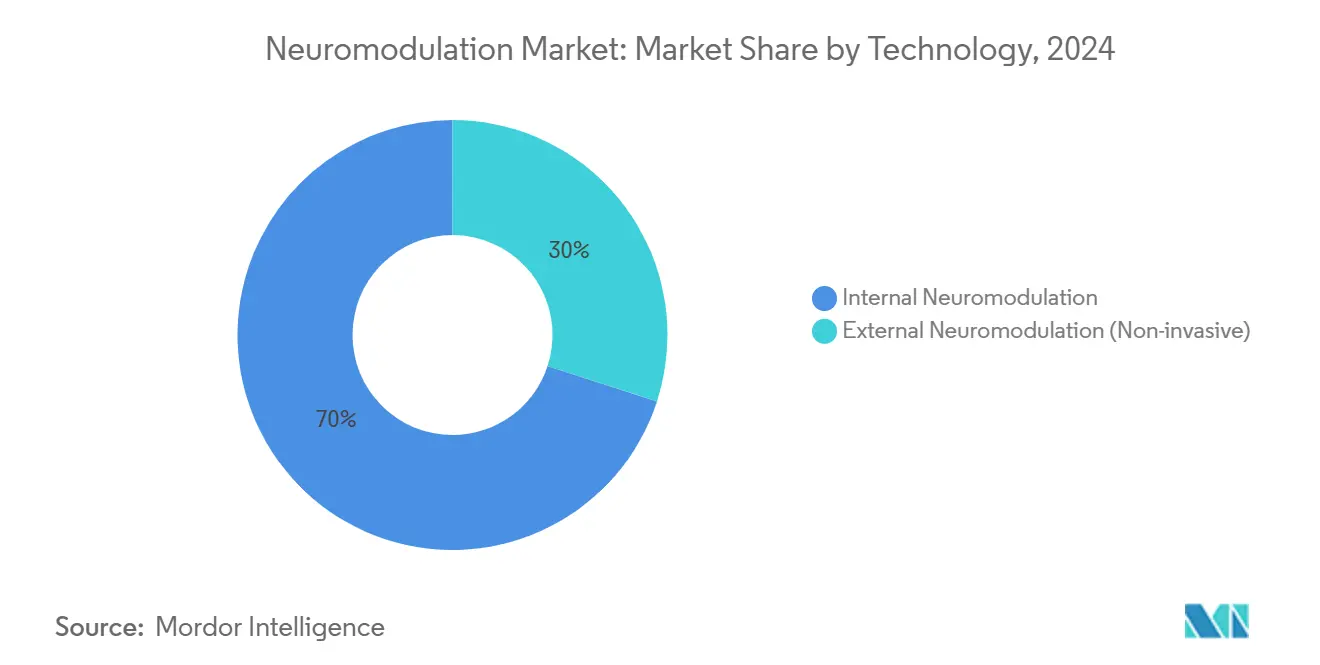
Note: Segment shares of all individual segments available upon report purchase
By Application: Pain Management Remains Primary, Neurological Disorders Accelerate
Pain therapies delivered 45.0% of the neuromodulation market in 2024, anchored by high-density burst spinal stimulation for refractory back pain. Peripheral nerve stimulators are emerging for focal neuropathies, giving physicians a spectrum of solutions before systemic drugs. Neurological applications such as Parkinson’s disease, dystonia, and epilepsy post the highest CAGR, supported by robust tremor-reduction evidence from advanced deep-brain stimulation. Consequently, the neuromodulation market size for neurological disorders is forecast to climb at a pace above the 8.64% industry average through 2030.
Manufacturers embed disease-specific algorithms and pre-set parameters, minimizing chair time for busy neurologists and widening adoption. Multidisciplinary centers combining pain and movement-disorder clinics funnel cross-referrals, boosting unit throughput. Closed-loop migraine implants promise the next leap, and vendors that secure early indication labels are poised for outsized returns.
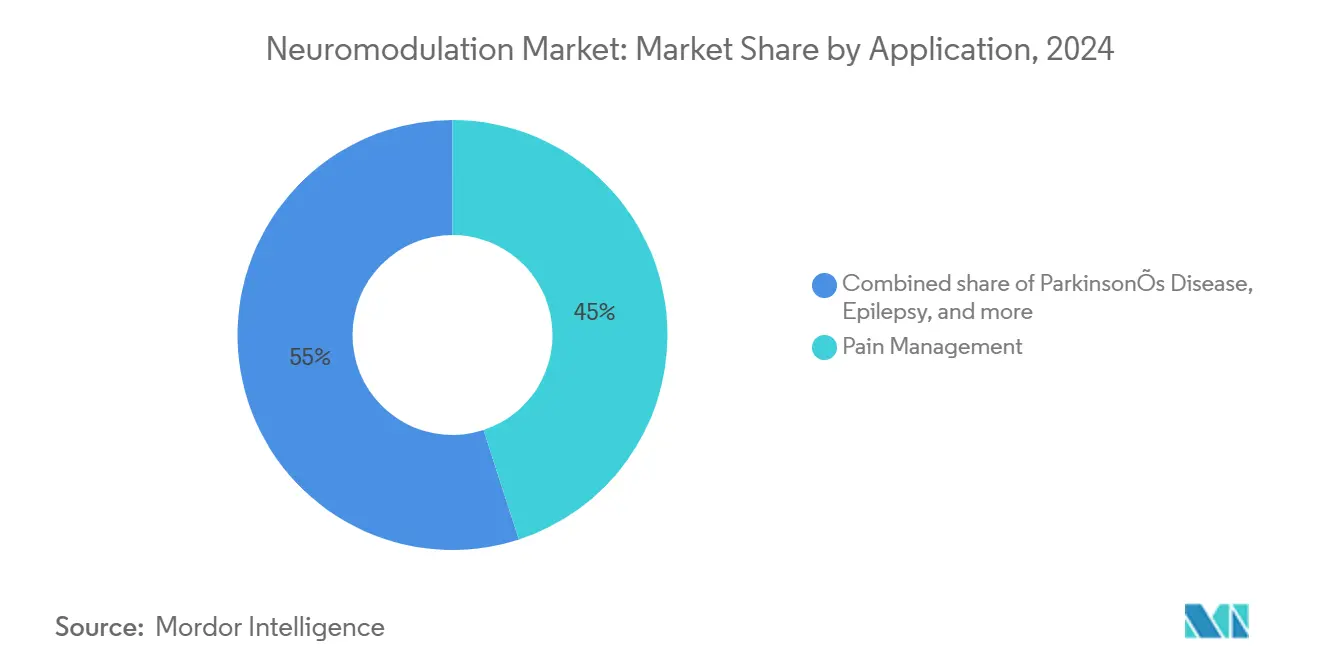
Note: Segment shares of all individual segments available upon report purchase
By End-User: Hospitals & ASCs Dominate, Outpatient Settings Expand
Hospitals and ambulatory surgical centers captured 60.0% of the neuromodulation market in 2024, reflecting infrastructure needs for device implantation. High-volume academic sites such as NYU Langone perform more than 100 deep-brain surgeries annually[3]NYU Langone Health, “Neuromodulation Technologies,” nyulangone.org. ASCs appeal to neurosurgeons with same-day discharge models that free acute-care beds. The neuromodulation market share of office-based clinics remains small but is set to grow as non-invasive stimulators avoid general anesthesia.
Training nurse practitioners in transcranial magnetic-stimulation protocols eases staffing bottlenecks, speeding expansion into community settings. Vendors now craft sales messages for surgical chiefs and allied professionals alike, ensuring consistent pipeline visibility across inpatient and outpatient pathways. Long-term contracts bundling implants with cloud programmers encourage facility retention and simplify inventory budgeting.
Geography Analysis
North America led the neuromodulation market with a solid 45.0% revenue share in 2024, buoyed by comprehensive insurance coverage and a mature clinical research infrastructure. FDA breakthrough designations shorten development timelines, allowing firms to commercialize earlier and recoup capital faster. Nationwide opioid-stewardship programs further raise neuromodulation’s profile as a front-line option. Academic-industry collaborations focus on AI-guided parameter optimization, turning the region into a live test bed for algorithmic neuromodulation.
Europe is the second-largest contributor and demonstrates a clear tilt toward non-invasive modalities. Germany and France dominate in deep-brain stimulation, whereas the United Kingdom’s NICE endorses repetitive transcranial magnetic stimulation for depression. Cross-border healthcare rules enable patients to seek specialized procedures abroad, driving traffic to centers of excellence. Procurement teams increasingly demand lifecycle carbon-footprint disclosures, favoring rechargeable generators. Suppliers offering cloud patient portals gain competitive advantage as digital care pathways mature.
Asia-Pacific is forecast to post the fastest 9.9% CAGR between 2025 and 2030, reflecting sizable unmet need and progressive reimbursement policies. China’s tier-one hospitals invest heavily in spinal-cord stimulation suites, and Japan’s insurance now covers responsive neurostimulation for drug-resistant epilepsy. Indian providers, dealing with high out-of-pocket spending, pilot installment payment plans. The ASEAN Medical Device Directive promises partial regulatory harmonization, potentially trimming market-entry timelines by up to 18 months. As local contract manufacturers increase component capacity, multinationals mitigate geopolitical risks while tapping growth in the neuromodulation market.
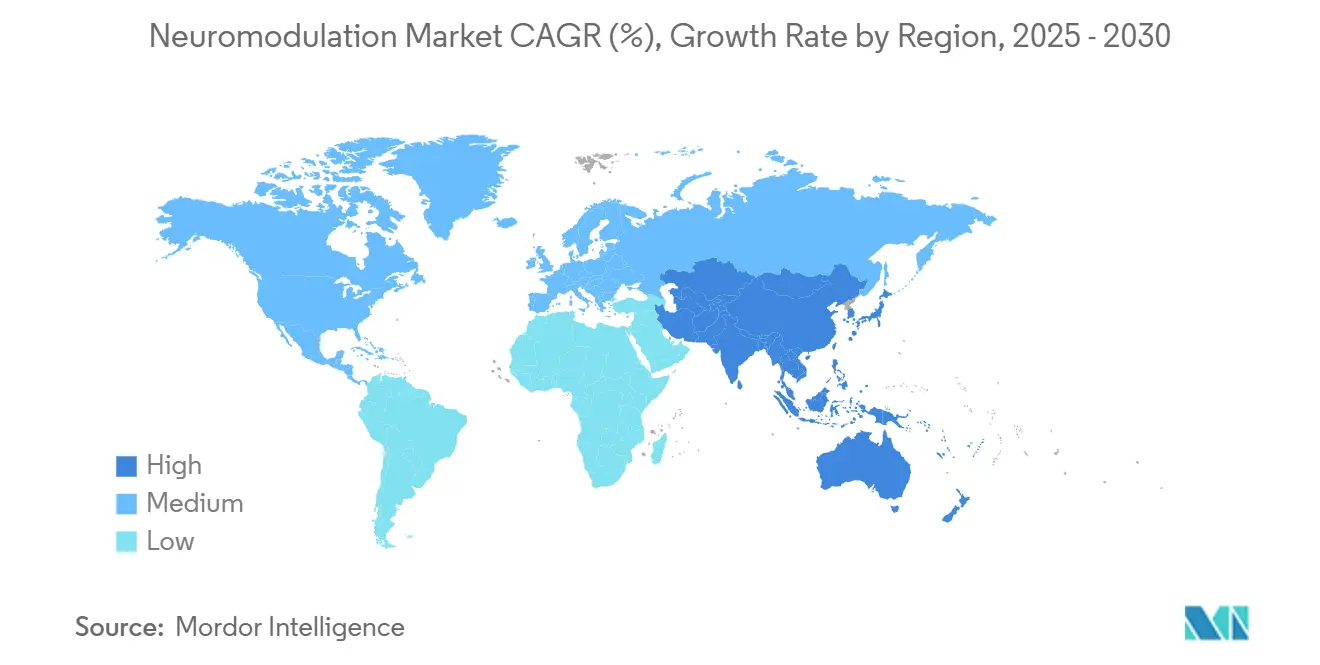
Competitive Landscape
Medtronic, Abbott, and Boston Scientific collectively controlled roughly 65% of global revenue in 2024, marking a moderately concentrated neuromodulation market. Each deploys proprietary waveforms—BurstDR, Spectra, and AdaptiveStim—to tailor neural engagement and fortify defensible niches. Litigation risk remains low because overlapping patents are limited, allowing the trio to focus on clinician education and remote programming portals. Battery and telemetry innovations are now the main differentiators, eclipsing earlier emphasis on lead architecture.
Mid-sized firms such as Nevro and Saluda push high-frequency and closed-loop feedback systems, undercutting incumbents on list price while touting superior pain-score reductions. Agile startups concentrate on neuroimmune modulation and optical stimulation, fields where large vendors lack immediate offerings. Venture capital inflows favor less invasive platforms due to smaller clinical trials and faster regulatory routes. Hospitals increasingly sign multisource procurement contracts to hedge supply risk, creating room for challengers and intensifying feature-set competition.
Strategic collaborations underscore the sector’s evolution toward data-driven care. Abbott’s alliance with a telehealth provider boosted NeuroSphere usage by adding video follow-ups and real-time symptom capture. Boston Scientific extends WaveWriter indications to non-surgical low-back pain, tapping underserved cohorts. Meanwhile, Feinstein Institutes’ wireless vagus stimulator sets the stage for fully implantable closed-loop systems. As procurement teams negotiate bundle discounts across product families, platform breadth rather than single-device superiority may decide future tenders in the neuromodulation market.
Neuromodulation Industry Leaders
-
Medtronic PLC
-
Abbott
-
Boston Scientific Corporation
-
LivaNova PLC
-
Nevro Corporation
- *Disclaimer: Major Players sorted in no particular order
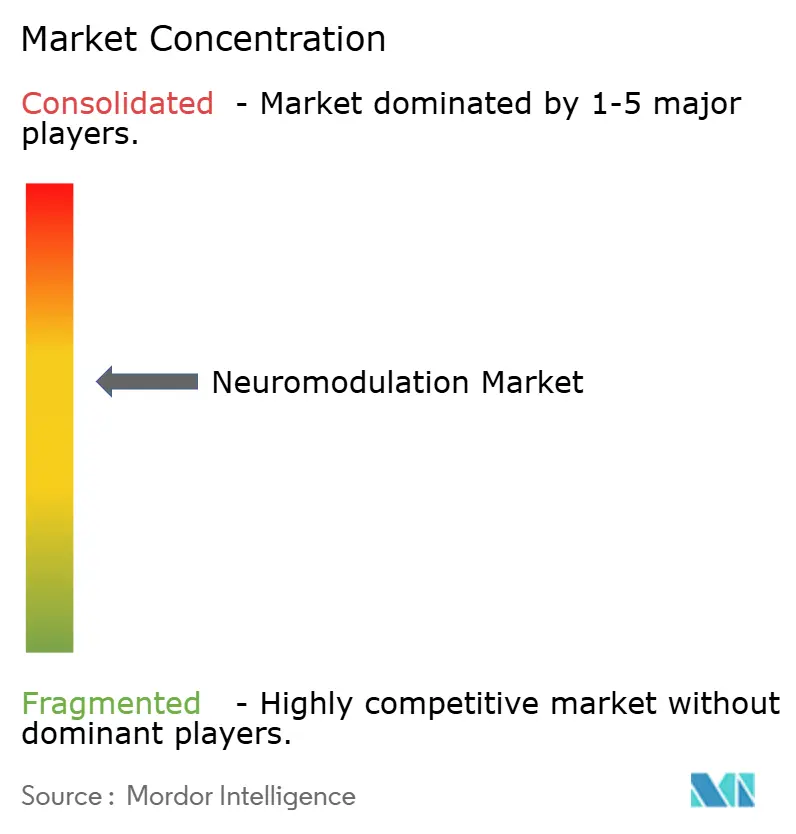
Recent Industry Developments
- March 2025: Feinstein Institutes researchers unveiled a fully implantable wireless bidirectional vagus-nerve stimulator, underscoring progress in bioelectronic medicine.
- January 2025: Abbott launched the Eterna spinal cord stimulation platform with Xtend energy technology, requiring as few as five charges per year, lowering maintenance burden.
- July 2024: Mainstay Medical secured EU, UK, and Australian approvals for full-body MRI compatibility of the ReActiv8 Restorative Neurostimulation system, expanding diagnostic flexibility for current and future patients.
- February 2024: Boston Scientific won FDA approval to extend WaveWriter spinal cord stimulation indications to non-surgical low-back pain, opening an underserved patient cohort.
- January 2024: Abbott obtained FDA clearance for the Liberta RC deep brain stimulation system; its extended battery life and remote programming set a new performance benchmark.
Research Methodology Framework and Report Scope
Market Definitions and Key Coverage
Our study defines the neuromodulation market as the worldwide sales revenue generated by implantable and external systems that deliver targeted electrical or chemical pulses to modulate neural activity for therapeutic benefit. These systems include spinal cord, deep brain, vagus, sacral, gastric, and transcranial stimulators, as well as peripheral external stimulators, accessories, and programmer units.
Scope Exclusion. The analysis omits radio-frequency ablation generators, general electro-therapy devices, and disposable pain patches, which do not provide programmable neuromodulatory output.
Segmentation Overview
- By Technology
- Internal Neuromodulation
- Spinal Cord Stimulation (SCS)
- Deep Brain Stimulation (DBS)
- Vagus Nerve Stimulation (VNS)
- Sacral Nerve Stimulation (SNS)
- Gastric Electrical Stimulation (GES)
- Other Internal Neuromodulation
- External Neuromodulation (Non-invasive)
- Transcutaneous Electrical Nerve Stimulation (TENS)
- Transcranial Magnetic Stimulation (TMS)
- Other External Neuromodulations
- Internal Neuromodulation
- By Application
- Pain Management
- Parkinson's Disease
- Epilepsy
- Depression
- Dystonia
- Other Applications
- By End-user
- Hospitals & Ambulatory Surgical Centers
- Clinics & Physiotherapy Centers
- Other End Users
- Geography
- North America
- United States
- Canada
- Mexico
- Europe
- Germany
- United Kingdom
- France
- Italy
- Spain
- Rest of Europe
- Asia-Pacific
- China
- Japan
- India
- South Korea
- Australia
- Rest of Asia-Pacific
- Middle-East and Africa
- GCC
- South Africa
- Rest of Middle East and Africa
- South America
- Brazil
- Argentina
- Rest of South America
- North America
Detailed Research Methodology and Data Validation
Primary Research
Multiple semi-structured interviews and survey pulses with neurosurgeons, pain specialists, reimbursement consultants, and procurement heads across North America, Europe, and Asia-Pacific sharpened adoption curves, average selling prices, and replacement timelines. These conversations let us test secondary assumptions, calibrate regional weightings, and refine scenario parameters before locking the model.
Desk Research
Mordor analysts started by mapping the market space with publicly available sources such as the US FDA 510(k) database, the European CE marking register, and reimbursement fee schedules from the US Centers for Medicare and Medicaid Services. Epidemiology updates from the World Health Organization, prevalence dashboards from the Global Burden of Disease study, and surgical-volume records held by the International Neuromodulation Society helped us set disease pools and procedure counts. Company 10-Ks, investor decks, and clinical-trial registries then supplied shipment signals and pipeline clues, which were cross-checked against news archives in Dow Jones Factiva and financial snapshots in D&B Hoovers. The list above is illustrative; many additional open datasets were reviewed to validate figures and narrative context.
Market-Sizing & Forecasting
A top-down demand pool was built by multiplying treated-patient cohorts derived from chronic pain incidence, Parkinson's and epilepsy prevalence, and surgical eligibility ratios by device penetration and replacement rates. Selective bottom-up roll-ups of major supplier revenues and sampled ASP × unit data served as a reasonableness check. Key variables include:
Annual spinal-cord stimulator implant counts,
Share of non-invasive TMS sessions per pain case,
Average selling price shifts as rechargeable IPGs grow,
National reimbursement coverage milestones,
Device longevity improvements influencing replacement cycles.
Multivariate regression, using GDP per capita and neurology workforce density as predictors, generated country-level growth coefficients that feed an ARIMA overlay for near-term shocks.
Data gaps in small markets were bridged by geographic proxies, then adjusted through expert feedback.
Data Validation & Update Cycle
Outputs pass three-layer reviews: analyst, senior analyst, and research manager to flag anomalies. Variance greater than two percentage points versus independent procedure tallies triggers re-contact with respondents. Models refresh annually; interim revisions occur after material regulatory approvals or product withdrawals.
Why Mordor's Neuromodulation Baseline Commands Confidence
Published values often differ because firms pick unique product baskets, currency years, and refresh rhythms.
Key gap drivers include divergent inclusion of disposable leads, differing ASP deflators, and whether external TENS is bundled with implantables. Mordor's disciplined scope alignment, annual model rebuild, and dual-stream validation keep our baseline balanced.
Benchmark comparison
| Market Size | Anonymized source | Primary gap driver |
|---|---|---|
| USD 6.64 B (2025) | Mordor Intelligence | |
| USD 6.81 B (2025) | Global Consultancy A | Counts radio-frequency ablation consoles and bundles service contracts |
| USD 6.37 B (2025) | Research Publisher B | Applies average USD-EUR 5-year FX rate instead of current-year spot |
| USD 9.07 B (2025) | Trade Journal C | Adds peripheral neuromodulation biomaterials and estimates ex-factory rather than end-user prices |
Taken together, the comparison shows that once inconsistent scopes and price bases are stripped away, Mordor's methodology delivers a transparent, repeatable view that decision-makers can rely on with confidence.
Key Questions Answered in the Report
How large is the neuromodulation market today and how fast will it grow?
The neuromodulation market stands at USD 6.64 billion in 2025 and is expected to reach USD 10.06 billion by 2030, expanding at an 8.64% CAGR.
Which segment currently leads the neuromodulation market?
Internal implantable systems lead with a 70% neuromodulation market share in 2024, driven by spinal cord and deep-brain stimulators backed by strong clinical evidence.
Which geographic area offers the fastest growth potential?
Asia-Pacific is forecast to post the fastest 9.9% CAGR between 2025 and 2030, fueled by expanded reimbursement in China and Japan and rising procedure volumes in India.
What are the main technological trends shaping future devices?
Closed-loop control algorithms, energy-efficient rechargeable pulse generators, MRI-safe optoelectronic leads, and cloud-linked remote programmers are setting new performance standards.
What key barrier can slow broader neuromodulation market adoption?
High upfront device and procedure costs, particularly in regions with limited insurance coverage, remain the most significant hurdle despite favorable long-term cost-effectiveness data.
Which companies dominate the competitive landscape?
Medtronic, Abbott, and Boston Scientific together account for roughly 65.0% of global revenue, leveraging proprietary waveforms and robust service networks to protect market leadership.
Page last updated on:
